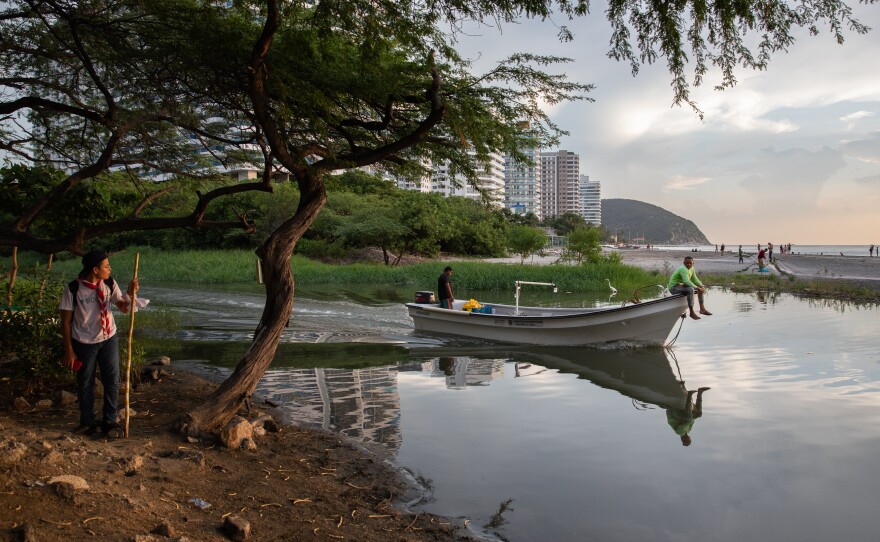SANTA MARTA, Colombia — For as long as she can remember, July Paola Merino has been waiting for water.
Pointing to a tangle of 1-inch white plastic pipes poking through the weeds and trash beside the dirt road just down the hill from her home, the 36-year-old mom says that this is where the water would flow from the local utility. But there hasn't been a drop for 28 days and counting.

Ana Troncoso, who lives next door to her daughter July, ran out of water the day before. She opens the square steel lid that sits atop the alberca — a concrete cistern just outside her front door. In her neighborhood, none of the homes has indoor plumbing. They store water in a cistern, which can hold about a two-week supply for washing laundry and dishes, bathing and flushing toilets, among other things.
Now there's only an inch of water on the algae-mottled bottom of the alberca, just enough to keep the tank from cracking in the 90-plus-degree summer heat, she explains.
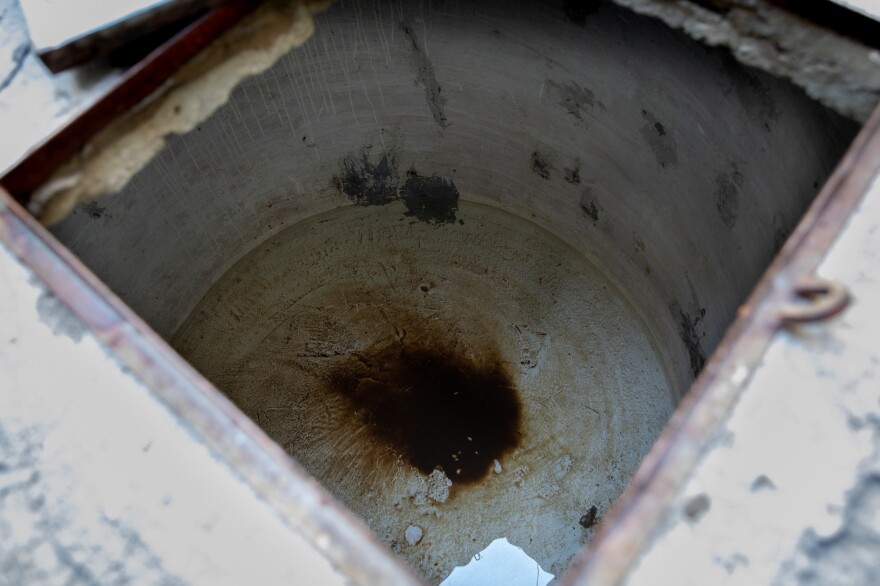
"I feel bad because we need the water more than electricity. If there's a power outage it's OK," says the 60-year-old, whose forehead is already glistening from the morning sun. "But without water it's bad, really bad."
Ana and July live in La Paz, a low-income neighborhood of 15,000 on the hilly outskirts of Santa Marta, a coastal city whose beaches and parks have made it a top tourist destination in Colombia. In the best of times, residents of La Paz gather water from the pipes in the streets once every two weeks to store in their cisterns. But July says that five years ago, the water company began providing water only once a month to her block.

They're among the 4 billion or so people — roughly half of the world's population — who experience severe water scarcityfor at least part of the year.
The water issue in La Paz is a citywide problem. The city's two water treatment facilities can pump out only around 25% of what the city needs, according to engineering professor Juan Guillermo Saldarriaga, a water expert at Los Andes University in Bogotá, Colombia.

"Leaks in the system. That's one big problem. You treat water and put it into pipes and it just leaks to the ground," says Saldarriaga. "Your infrastructure is getting older there and then you have more people to feed [the water to]. And so that's why the problem is becoming worse every year that passes."
The population of Santa Marta has more than doubled in the last 30 years to about 550,000, swelled recently by an influx of immigrants from Venezuela. Colombians from small towns looking for jobs and fleeing security issues created by drug trafficking have also been moving to the city.

"Nearby we have an invasión with approximately 800 land lots, which means 800 families, with an average of five people per family, which means 4,000 new people in this community. Most of these people are Venezuelans," explains Carlos Ramos, a 26-year-old community leader who has lived in La Paz all his life and aspires to be a neighborhood representative in the city government of Santa Marta.
Invasión is the term Colombians use to describe an area where people settle illegally.
"The more people come here, the less water we have for everyone because we have to share it," Ramos adds.
It used to be jugs on donkeys
When Ana Troncoso moved here with her family more than 30 years ago, in 1991, the neighborhood was still an invasión. There were only three houses near her home in La Paz at the time.

Her daughter July recalls fetching water from a creek on the mountainside with her mother when July was a little girl. They carried water back to their house in jugs strapped to a donkey.
The situation today is not that much better.
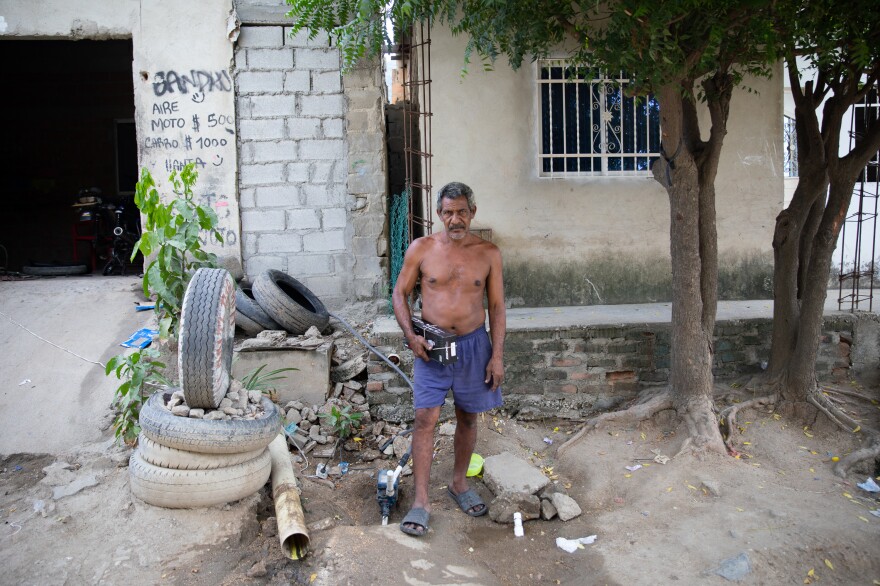
"People keep saying, 'I've run out of water today. I'm parched. I don't have any water at home to take a shower. I don't have water at home to cook. I don't have any money to buy it.' Those are the cries for help that we hear as community leaders," says Ramos.
"It's terrible. It makes you notice the societal backwardness and the delay in infrastructure improvements."
City officials did not respond to NPR's repeated requests for an interview.
An improvised water system

To get water from the pipes in the street to people's homes, residents have improvised a relatively inexpensive solution.
Ramos asks us to follow him down the dirt road about a two-minute walk from where he lives to show us their makeshift system. We stop at a barbed wire fence, where 10 hoses are strewn amid the rocks. Electrical outlets hang precariously from the top of a tall wooden post nearby. This is one of the major water collection points for the neighborhood.
Ramos explains that 40 to 50 people typically gather here each month, sharing the connections for their small motor pumps that push the water from the main pipe through their hoses into their albercas hundreds of feet away.

The water typically comes in fits and starts that last 15-20 minutes — if at all. Family members take shifts plugging and unplugging their motor pumps into the electrical outlets that they've run from their homes so the motors don't burn out when the water stops. They work methodically, careful not to splash water on the outlets so they don't electrocute themselves.
It's a laborious and not especially safe solution, but it's the best option for a community where money is tight. Most of the people work in the informal sector, el rebusque (the hustle) as they say in Colombia, doing odd jobs like peddling souvenirs to tourists or painting houses to make ends meet.
"It's outrageous when we see our elders in our community, staying up all night, in the streets," Ramos says. "Sometimes wasting that night because the water didn't even come and then having to get ready to go to work in the morning."
"The Pearl of America" has lots of water — but not for average citizens
Across the city, water rationing is part of daily life in Santa Marta. You can only expect to get water by turning on your faucet in wealthier neighborhoods and tourist areas with restaurants and hotels. They pay the highest rates for water.
The price for water in places like La Paz, on the other hand, is heavily subsidized by the city. Ironically, this takes away the monetary incentive for the water company to better service the area, says Saldarriaga.

What is especially galling to people in Santa Marta is that they know their city is rich with freshwater resources. The Spaniards chose this coastal area to establish their first settlement in Colombia in 1525 for this reason, christening it "The Pearl of America."
More than 30 rivers flow in and around the city from the snowy caps of the Sierra Nevada, one of the highest coastal ranges in the world. Some rivers weave through the neighborhoods, bending around parks and running behind shops before emptying into the Caribbean Sea.
Water is everywhere, except in the pipes.
And even when water is available, residents in La Paz are leery about drinking it. Those who can afford it buy bagged water or bottled water for drinking, Ramos says.
July says her family buys drinking water almost every day. It's a significant expense for herself, her husband and their three children. July works as a pool attendant at the Marriott Hotel, earning the minimum wage of around 1.2 million pesos per month — about $250. As a building maintenance man, her husband makes a little more plus bonuses.

Five years ago, when the water company began supplying water rations only once a month instead of every two weeks, July says her family's quality of life and finances were affected. It meant they would get only half the water they used to receive for daily needs.
As the family nears the end of the month and the water in their alberca starts to run low, they go into emergency mode. July showers at work. The family reuses bathwater to flush the toilet. They borrow water from family and neighbors. They buy legumes instead of meat at the grocery store to save their money to get water from other sources.
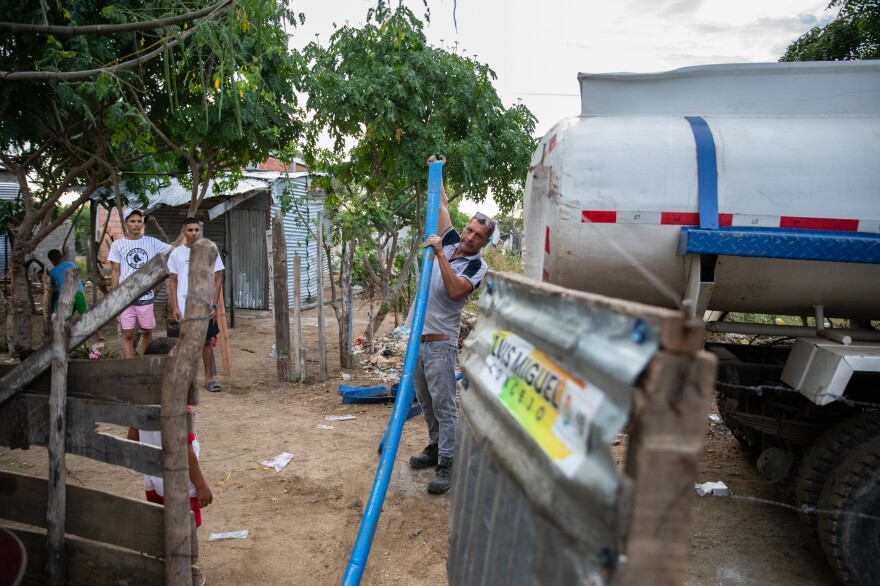
A few months ago, when the water didn't come on time and no one they knew had water to spare, July's family called Ramos as a last resort. He arranged for a water tank delivery, a fairly reliable but expensive alternative to the water pipes in La Paz. One water tank delivery costs about 150,000 pesos — about $37. That's more than half a week's wages for a minimum wage worker like July.
"Water is the most important for us, but we shouldn't have to choose, so we are sacrificing other things for our family. We sacrifice buying things for our house, so we can get water," says Ramos.
Residents are frustrated that they can't get officials from the city or water company to move more quickly to improve the water distribution in La Paz after so many years of promises.

"We decided that if the water company doesn't answer, then the citizens, for example, will block the roads," explains Ramos. "We, as leaders, have stopped the community from doing it, because we have told them that we are going to keep on dialoguing, trying to improve the water situation."
In the last few months, talks with the municipal water company have been more productive. The company installed new equipment at three connection points in one sector of La Paz. That enables more residents to connect to the main water pipes for twice a month delivery, according to Nelinton Humberto Guerrero Pelaez, a community leader.
Guerrero says that a water company official also met with the community last month to listen to their concerns.
"We have to keep on pushing to get our precious liquid. That's what we want, for God to bless us, so we can have the service 24/7," he says.
Real-life magical realism
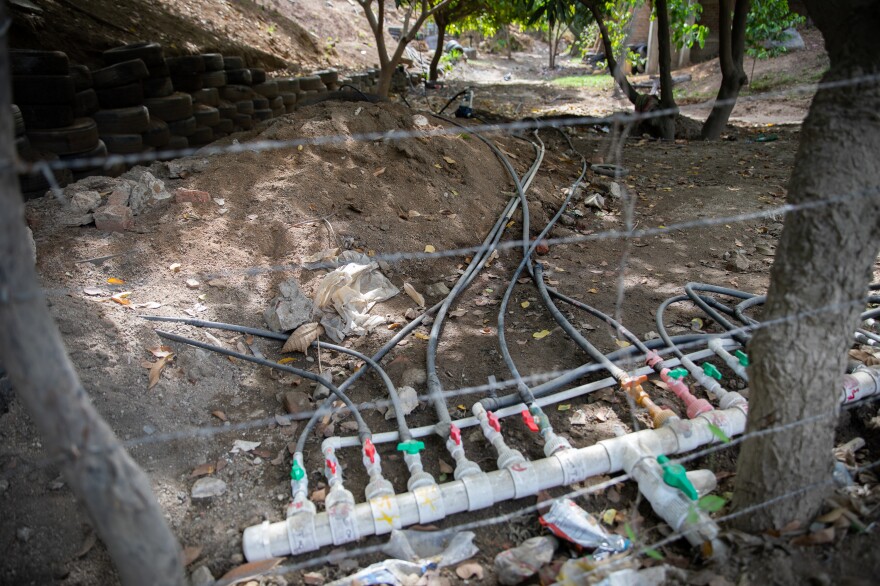
Whether the city will commit to spending the money to upgrade the water distribution for the entire community and the entirety of Santa Marta is an open question.
Professor Saldarriaga's research group had presented a plan to improve the water system that, if implemented, would have solved the city's major water problems two years ago, he says. But city officials never acted on it.
"It's a surprise that they haven't started anything. I mean, they haven't laid just a single brick in the town to solve this problem," he says.

"This is Macondo," says Saldarriaga, referring to the city in the magical realism novel One Hundred Years of Solitude by Colombian Gabriel García Márquez. "Anything as crazy as you can imagine happens in Macondo — anything — that's Santa Marta. Santa Marta is the modern Macondo."
The latest city plan to fix the water issues in Santa Marta is expected to start in 2024, Ramos says. But he remains skeptical, like other residents, that the city will follow through. And with the mayoral election in October still unresolved, it's unclear whether a new administration will have the same priorities.

Even if the city followed through on the plan, Ramos say it would take at least four to five years to complete the improvements to the water system.
"Today we have hope that maybe in five years we can have improvements in the water issues," Ramos says. "How can we wait for so long when water is such a vital need?"
"What we all really want is them giving us water twice a week. That would help us a lot," says July, who's still not on a monthly delivery schedule. "We wouldn't have to think about it too much because waiting is exhausting."

Tatiana Posada, an interpreter and fixer in Colombia, and Christina Noriega, a journalist in Colombia, contributed to this report.
Copyright 2024 NPR



